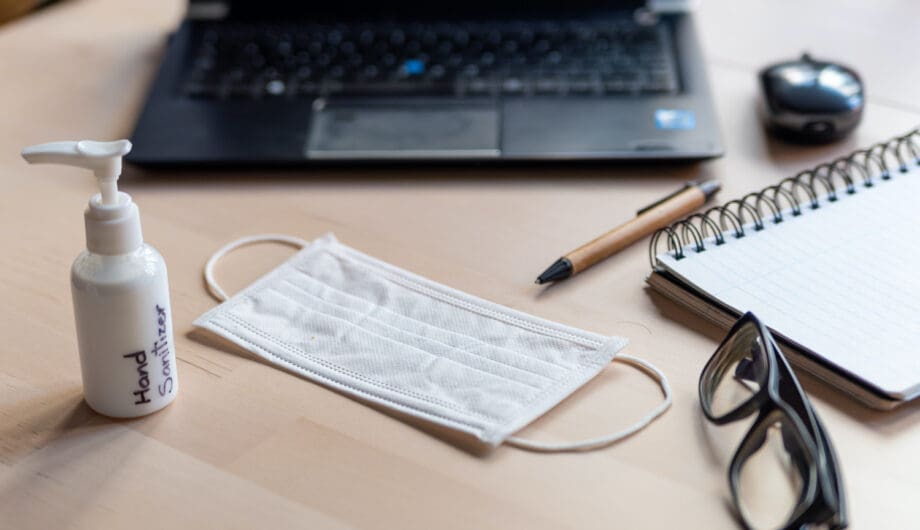
We are extremely fortunate at at Sumy Designs to be able to work from home, but we understand that working from home isn’t an option for some of our clients. As many of us go back to work and as our kids go back to school and universities begin to reopen, it is more important than ever to follow guidance from the Centers for Disease and Control to ensure your health and the health of your co-workers and employees. We care about our clients, so we’ve put together a checklist to help ensure your safety and the safety of your employees and co-workers.
Communicate
If working from home isn’t an option, it is essential that supervisors communicate the guidelines that are being established. Let your employees and co-workers know these plans are being taken to ensure their safety and keep the office space they occupy in a state that reduces spread of the virus. If you are a manager or supervisor, be as transparent as possible, letting your co-workers and employees know that these guidelines are established for their safety could, and probably will, change as new information about the virus and its control is gathered.
Practice self-screening
Make sure your and co-workers are practicing self-screening. If you were within 6 feet of a person with a lab-confirmed case of COVID-19 for at least 5 minutes, or had direct contact with their mucus or saliva, in the past 14 days report it to your supervisor immediately. If you are the supervisor, make sure your employees know to report all suspected and confirmed cases of COVID-19, as well as close, prolonged exposure to other individuals who may have COVID-19. Establishing a confidential online form for reporting is a good option and encourages reporting.
Know the symptoms
COVID-19 affects different people in different ways. Those infected have had a vast range of symptoms reported that vary from mild to severe illness. Symptoms may appear 2-14 days after exposure to the virus.
People with these symptoms may have COVID-19:
- Fever or chills
- Cough
- Shortness of breath or difficulty breathing
- Fatigue
- Muscle or body aches
- Headache
- New loss of taste or smell
- Sore throat
- Congestion or runny nose
- Nausea or vomiting
- Diarrhea
Organize and clean the workspace
Work areas should be cleaned regularly, and high touch surfaces (e.g., door knobs, tables, computer keyboards, handrails, shared equipment) be disinfected more frequently. If you are a supervisor, you should consider placing spray bottles of disinfectants and paper towels in common areas.
- Consider workplace directional flow to limit cross traffic, if feasible
- For surfaces potentially touched by multiple workers, clean and disinfect more frequently
- For surfaces touched by a single worker, clean and disinfect periodically or when unclean
- Wipe down shared equipment, including keyboards and mice, frequently
- Follow the manufacturer’s instructions for use of all cleaning and disinfecting products
Prevent close interactions between employees and others
- Maintain at least 6 feet between people
- Face coverings should be worn indoors unless alone in a private area
- Separate work stations by at least 6 feet or use physical barriers (e.g. curtains, shields)
- Allow only infrequent and intermittent passing within 6 feet
- Ensure social/physical distancing during breaks and at shift start and end times
- Organize work to break up tasks in a manner that facilitates social distancing or other protective measures
- Limit in-person meetings to locations where 6-foot distancing is possible
- Avoid hugging and handshakes
- Do not ride with co-workers in vehicles if possible
- Replace in-person meetings with web-based meetings
Reduce the risk of spreading
Remind co-workers and employees they can reduce the risk of spreading COVID-19 by taking the following steps to help prevent infection:
- Wash hands often with soap and water for at least 20 seconds. If water is not available, use hand sanitizer with at least 60% alcohol
- Avoid touching your eyes, nose, or mouth with unwashed hands
- Avoid contact with people who are sick
- Stay home while sick and avoid close contact with others
- Cover your mouth and nose with your elbow or a tissue when coughing or sneezing, and immediately dispose of the used tissue
- Disinfect surfaces frequently
Create a schedule and safe space
- Put together a schedule that outlines the entire day from the moment you leave for work until the end of the day.
- Minimize the number of people in your work area at the same time
- Small, narrow offices/facilities on the order of 100-150 square feet can likely accommodate only one person at a time
- Square or rectangle work areas larger than 200 square feet can likely accommodate more people, but maintain 6-foot distancing
Washing hands keeps you, and those around you, healthy.
The primary and most important mode of transmission for COVID-19 is through close contact from person-to-person. Based on data from lab studies on COVID-19 and similar respiratory diseases, it may be possible that a person can get COVID-19 by touching a surface or object that has the virus on it and then touching their own mouth, nose, or possibly their eyes, but this isn’t the main way the virus spreads.
Key times to wash hands:
- Before, during, and after preparing food
- Before eating food
- Before and after caring for someone at home who is sick
- Before and after treating a cut or wound
- After using the toilet
- After contact with high touch surfaces (e.g., elevators, lobby areas, reception desks, etc.)
- After blowing your nose, coughing, or sneezing
- After removing gloves or other personal protective equipment
- After touching an animal or animal waste
- After touching garbage
Some additional resources:
EPA Approved Disinfectants for Use Against COVID-19
World Health Organization Q&A for social measures in the workplace
Susan Sullivan
Susan lives in the Dallas/Fort Worth Metroplex area with her husband and children. She is an avid distance runner, environmentalist, part-time beekeeper, chicken farmer and amateur photographer.
